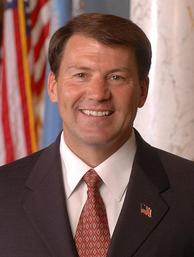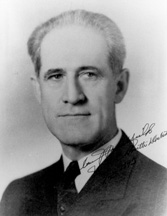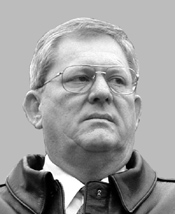Rounds Seeks 1st US Senate Win for ex-South Dakota Governor
No former governor has ever won a U.S. Senate seat in South Dakota, with the last sitting governor to do so 70 years ago

While Republicans have stumbled in states ripe for the party’s picking over the last two cycles due to flawed candidates emerging from the GOP primary (e.g. Delaware and Nevada in 2010, Indiana and Missouri in 2012), Rounds is a popular, known quantity in the Mount Rushmore State and would be a legitimate opponent for three-term Democratic incumbent Tim Johnson.
However, it is not a given that Rounds, who has been out of office for nearly two years, will have a clear path to the nomination, with at-large GOP U.S. Representative Kristi Noem a potential contender to make a run at Tim Johnson’s seat.
In fact, ex-governors in South Dakota have struck out every time they’ve sought a U.S. Senate seat over the decades – with only one even attempting such a move since the end of World War II.
A Smart Politics analysis finds that no ex-governor has been elected to the U.S. Senate from South Dakota in state history, with five of the last six campaigns by ex- or sitting governors ending in failure since the Great Depression.
Rather than make a controversial run at the U.S. Senate at the end of his term and challenge popular one-term Republican John Thune in 2010, Rounds opted to sit out two years and take his chances against Tim Johnson.
However, there is no historical blueprint for success in the Mount Rushmore State that Rounds can use as a guide to win a senate seat:
· Republican Governor Frank Byrne (1913-1916) was the first ex-governor to try to win a U.S. Senate seat from South Dakota.
Byrne was two years removed from the end of his second term in 1918 when he lost a two-way GOP primary to Thomas Sterling by 11 points, 55.5 to 44.5 percent.
· Former two-term Democratic governor Tom Berry (1933-1936) ran for the U.S. Senate in 1938, but was defeated by Chan Gurney by 5.0 points, 52.5 to 47.5 percent.
Berry then made a second attempt at a U.S. Senate run in 1942, but was defeated in the general election by 17.4 points by sitting GOP governor Harlan Bushfield.
· Former two-term Republican governor Archie Gubbrud (1961-1964) attempted to unseat one-term Democratic incumbent George McGovern in 1968, but lost by 13.6 points, 56.8 percent to 43.2 percent.

Bushfield defeated his Democratic gubernatorial opponents by eight and 10 points in 1938 and 1940 before embarking on his U.S. Senate run at the end of his second term.
He faced former two-term Democratic governor Tom Berry who had knocked out U.S. Senator (and former governor William Bulow) in the party’s primary that year.
Bushfield cruised to a 17.4-point victory in the governor on ex-governor matchup, but died before his term ended in 1948.
In addition to Bushfield, the remaining four South Dakota governors who enjoyed successful U.S. Senate bids during the early part of the 20th Century – all had one thing in common: they won their seat while still serving as governor:
· Republican Coe Crawford (1907-1908) was the first governor from the Mouth Rushmore State to win a U.S. Senate seat, doing so at the end of his first term in 1908.
· Republican Governor Peter Norbeck (1917-1920) was elected to the U.S. Senate at the end of his second term as governor in 1920.
· Republican Governor William McMaster (1921-1924) won a U.S. Senate seat at the end of his second term in office in 1924.
· Democrat William Bulow (1927-1930) was elected to the senate at the end of his second term in office in 1930.
Two other sitting governors launched U.S. Senate bids, but came up short:

While wrapping up his second four-year term as governor in 1986, Janklow launched a primary challenge against one-term Republican U.S. Senator James Abdnor.
Abdnor defeated Janklow by nine points in the GOP primary – 54.5 percent to 45.5 percent.
The other sitting governor who lost his U.S. Senate bid was Republican Leslie Jensen.
Jensen served as governor from 1937-1939 and lost in a four-way 1938 GOP primary to Chan Gurney, 46.8 to 38.7 percent.
Interestingly, all five sitting South Dakota governors who managed to win a U.S. Senate seat did not go out on their own terms – either losing the party’s nomination, losing reelection, or dying in office:
· Republican Coe Crawford lost his renomination bid for a second term in the senate in 1914.
· Republican William McMaster was defeated in his 1930 reelection campaign for a second term.
· Republican Peter Norbeck died in his third term in office in 1936.
· Democrat William Bulow was defeated in the 1942 primary after two terms.
· Republican Harlan Bushfield died in his first term in office in 1948.
U.S. Senate Candidacies by Ex- or Sitting South Dakota Governors Since Statehood
|
Governor
|
Party
|
Served
|
US Senate bid
|
Gap
|
Result
|
|
Coe Crawford
|
GOP
|
1907-1908
|
1908
|
In office
|
Won
|
|
Frank Byrne
|
GOP
|
1913-1916
|
1918
|
2 years
|
Lost primary
|
|
Peter Norbeck
|
GOP
|
1917-1920
|
1920
|
In office
|
Won
|
|
William McMaster
|
GOP
|
1921-1924
|
1924
|
In office
|
Won
|
|
William Bulow
|
Democrat
|
1927-1930
|
1930
|
In office
|
Won
|
|
Tom Berry
|
Democrat
|
1933-1936
|
1938
|
2 years
|
Lost general
|
|
Leslie Jensen
|
GOP
|
1937-1938
|
1938
|
In office
|
Lost primary
|
|
Tom Berry
|
Democrat
|
1933-1936
|
1942
|
6 years
|
Lost general
|
|
Harlan Bushfield
|
GOP
|
1939-1942
|
1942
|
In office
|
Won
|
|
Archie Gubbrud
|
GOP
|
1961-1964
|
1964
|
4 years
|
Lost general
|
|
William Janklow
|
GOP
|
1979-1986
|
1986
|
In office
|
Lost primary
|
Note: Gubernatorial terms extend into the first week of the subsequent odd-numbered year. Table compiled by Smart Politics.
Follow Smart Politics on Twitter.
